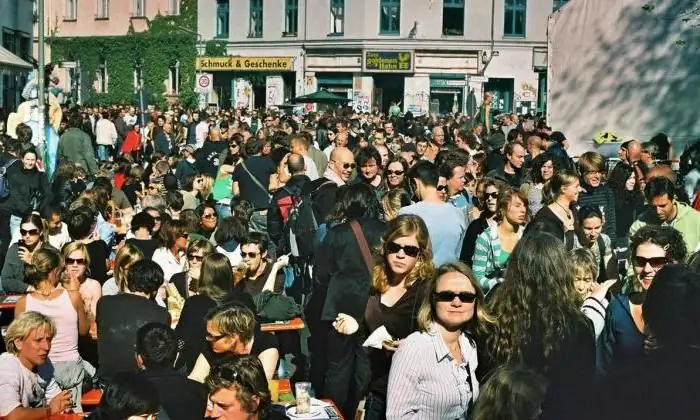- Author Henry Conors [email protected].
- Public 2024-02-12 02:55.
- Last modified 2025-01-23 09:07.
A small town in the Ulyanovsk region did not escape the fate of renaming, according to the Soviet tradition. In 1972, the Melekessians became Dimitrovgradians. The population of Dimitrovgrad has been constantly decreasing in recent decades, which is due to the poor state of the city's economy.
General information
The city is the administrative center of the urban district of the same name and the Melekessky district of the Ulyanovsk region. It is located on the left bank of the Kuibyshev reservoir not far from the confluence of the Bolshoi Cheremshan River. At a distance of 85 km is the regional center, the nearest cities of the neighboring Samara region: about 160 km to Samara, 100 km to Tolyatti. It occupies an area of about 4150 hectares. The population of Dimitrovgrad was 116,678 in 2016.

Historical name - Melekess. It was renamed in connection with the 90th anniversary of the Bulgarian anti-fascist and activist of the communist and labor movement Georgy Dimitrov.
Recognized by the Government of Russia as a single-industry town with a very difficult socio-economic situation. Works in the city districtabout 40 industrial enterprises representing various industries, including engineering, construction.
Geographic Information

Located in the left-bank part (Zavolzhye) of the Ulyanovsk region in the middle Volga region, not far from the confluence of the Bolshoi Cheremshan and Melekessk rivers into the Kuibyshev reservoir. Terrain fluctuations are insignificant within 50-100 meters above sea level.
During the development of the western districts of the city in the middle of the twentieth century, large areas of forests with pine forests and mixed forests were preserved. Therefore, the population of Dimitrovgrad often calls this western part "a city in the forest." The ecological situation in the region is determined by the key elements of the natural landscape - large reservoirs (reservoir and rivers), large forest areas in the urban area and large areas with park areas.
Ancient history

The settlement of the territory of the modern city, between the Volga and Cheremshan, began in the second half of the 17th century. Under the Russian Tsar Alexei Mikhailovich, the construction of a fortified line began here to protect against raids by nomadic peoples - Kalmyks, Kirghiz and Bashkirs. In 1656, peasant families from the Yelabuga district of the Vyatka province, including from the small Tatar settlement of Melekes, were forcibly relocated to these places. In memory of their native places, the river and the new village of Melekess were named, however, in the fashion of those times, they added another letter "s".
The exact date of the founding of the cityIt was not possible to establish, therefore, 1698 was taken as this date, when the village of Yasak Chuvashs was built. The first written mention refers to 1706, it contains a record of the participation of local peasants in public works on surveying the volost. There is no data on how many people lived in Dimitrovgrad at that time. But all people were the property of the royal family. The main occupation of the inhabitants was agriculture, cattle breeding, fishing and hunting.
Pre-revolutionary city

By 1890, Melekess had become a developed industrial city with 18 factories and plants, including breweries, tanneries, potash, and soap factories. According to the All-Russian census, 8,500 people lived in the settlement, of various classes.
In subsequent years, urban industry and trade developed successfully, by 1910 the turnover reached 2-3 million rubles. The population of Dimitrovgrad / Melekess was 9878 people, 88% of whom were Russians. About 1,500 wooden and 500 stone houses were built in the settlement. According to the latest data of the tsarist period in 1915, about 16,000 people lived in the city.
Soviet period

During the years of Soviet industrialization, there was a rapid increase in the number of residents of Melekess, mainly due to the influx of peasants from the surrounding villages who came to work at industrial enterprises. From 1931 to 1939 the population of Dimitrovgrad/Melekess grew from 18,900 to 32,485. During the war years, 6,000 evacuees lived in the city. FromKnitting factory named after Clara Zetkin was moved to Vitebsk, which continued to work in the city after the war.
In 1956, the construction of a complex of the research institute of the atomic industry and a residential town for its employees, now the Western District, began. By 1967, the number of inhabitants had grown to 75,000. In the subsequent Soviet years, the modern appearance of the main regions (Western, Pervomaisky and Central) was finally formed after the transfer of the factory named after. K. Zetkin. In the last year of Soviet rule, the population of Dimitrovgrad was 127,000.
Modernity

With the collapse of the Soviet Union, the privatization of industrial enterprises began in the city, more than 20 large plants and factories were transferred to private hands. One of the first was corporatized knitting factory "K. Zetkin". By 1992, the population of Dimitrovgrad had increased to 129,000 thousand. In subsequent years, despite the economic crisis, the number of residents continued to grow. The increase was mainly due to an insignificant migration inflow. The population of Dimitrovgrad reached its maximum value of 137,200 in 1999.
In 2000, the city had 137 thousand inhabitants. Due to the low supply of jobs, people began to leave for more prosperous regions, wanting to find work with decent pay. In the new century, with the exception of two years (2008 and 2009), the population of the city of Dimitrovgrad has been constantly decreasing. In some years, the population for the most part decreased due tonatural loss. In 2017, the population of Dimitrovgrad decreased to 116,055 people. This is 21,000 less than in 1999.






